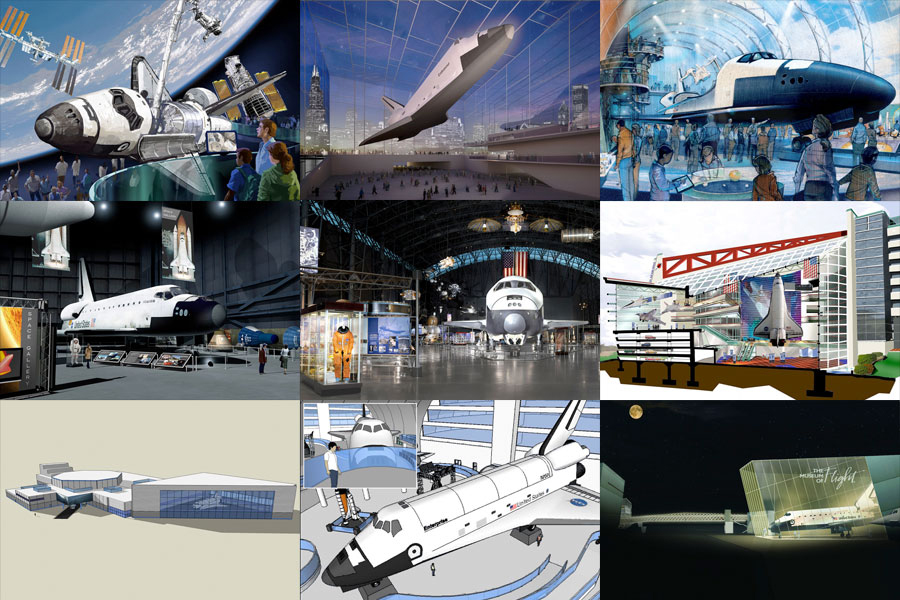
This story was updated on April 11 at 7 a.m. ET.
NASA is expected to announce the final resting places of the agency's space shuttles Tuesday (April 12), on the 30th anniversary of the first-ever shuttle mission.
NASA is retiring the shuttle program later this year, and nearly two dozen museums around the country are vying for the right to display one of the workhorse orbiters. Up for grabs are the shuttles Discovery, Endeavour and Atlantis — important pieces of spaceflight history that would doubtless pull many visitors through the doors.
That's the idea, for both the museums and NASA. The space agency has said it wants the shuttles to continue serving the nation in retirement by jump-starting the public imagination and helping lead young people into careers in math and science.
"The shuttle program accomplished many outstanding things for this nation, and in 2012 we look forward to moving our retired orbiters to museums and science centers across the country to inspire the next generation of explorers," NASA chief Charlie Bolden said in a statement to Congress last month. [The Most Memorable Shuttle Missions]
Twenty-one contenders
When NASA first solicited proposals from museums interested in displaying a shuttle back in 2008, 29 institutions answered the call. Since then, eight have dropped out for various reasons, bringing the list of contenders to 21.
Get the Space.com Newsletter
Breaking space news, the latest updates on rocket launches, skywatching events and more!
NASA has laid out a few criteria that must be met by the hopeful museums. The institutions have to be in the United States or one of its possessions, for example, and must be able to house a shuttle in a climate-controlled indoor display or storage space. [How to display a retired space shuttle]
The museums also must be ready to accommodate a shuttle delivery — on the back of a Boeing 747 jet — by December 2011. And, last but certainly not least, they must be willing to foot the estimated $28.8 million bill for shuttle preparation and transport. (The Smithsonian National Air & Space Museum in Washington, D.C. has been let off the hook for this one, with Congress promising the funds for a shuttle would not come out of the institution's normal budget.)
So far, NASA has kept quiet about the shuttles' destinations. However, the shuttle Discovery — which completed its final STS-133 mission last month — appears headed to the Smithsonian, which received an unofficial promise of the orbiter from NASA back in 2008. [Photos: The First Shuttle Launch, STS-1]
The front-runners
The Smithsonian currently houses the shuttle Enterprise, a prototype that made some glide tests but never reached space. Discovery is expected to replace it, putting Enterprise up for grabs along with Endeavour and Atlantis.
While only Bolden and his team know for sure which museums will get these shuttles, experts have identified several front-runners.
They include the visitor center at NASA's Johnson Space Center in Houston; the visitor center at Kennedy Space Center in Florida; the National Museum of the U.S. Air Force in Ohio; the Museum of Flight in Seattle; and the Intrepid Sea, Air & Space Museum in New York City.
But all of this is speculation until Tuesday. Bolden's announcement — which also comes on the 50th anniversary of the first human spaceflight, by cosmonaut Yuri Gagarin in 1961 — will lift the spirits of a few museum officials and disappoint many others.
And it will help families and schools start planning trips to see a piece of American spaceflight history up close.
You can follow SPACE.com senior writer Mike Wall on Twitter: @michaeldwall. Follow SPACE.com for the latest in space science and exploration news on Twitter @Spacedotcom and on Facebook.
Join our Space Forums to keep talking space on the latest missions, night sky and more! And if you have a news tip, correction or comment, let us know at: community@space.com.

Michael Wall is a Senior Space Writer with Space.com and joined the team in 2010. He primarily covers exoplanets, spaceflight and military space, but has been known to dabble in the space art beat. His book about the search for alien life, "Out There," was published on Nov. 13, 2018. Before becoming a science writer, Michael worked as a herpetologist and wildlife biologist. He has a Ph.D. in evolutionary biology from the University of Sydney, Australia, a bachelor's degree from the University of Arizona, and a graduate certificate in science writing from the University of California, Santa Cruz. To find out what his latest project is, you can follow Michael on Twitter.









